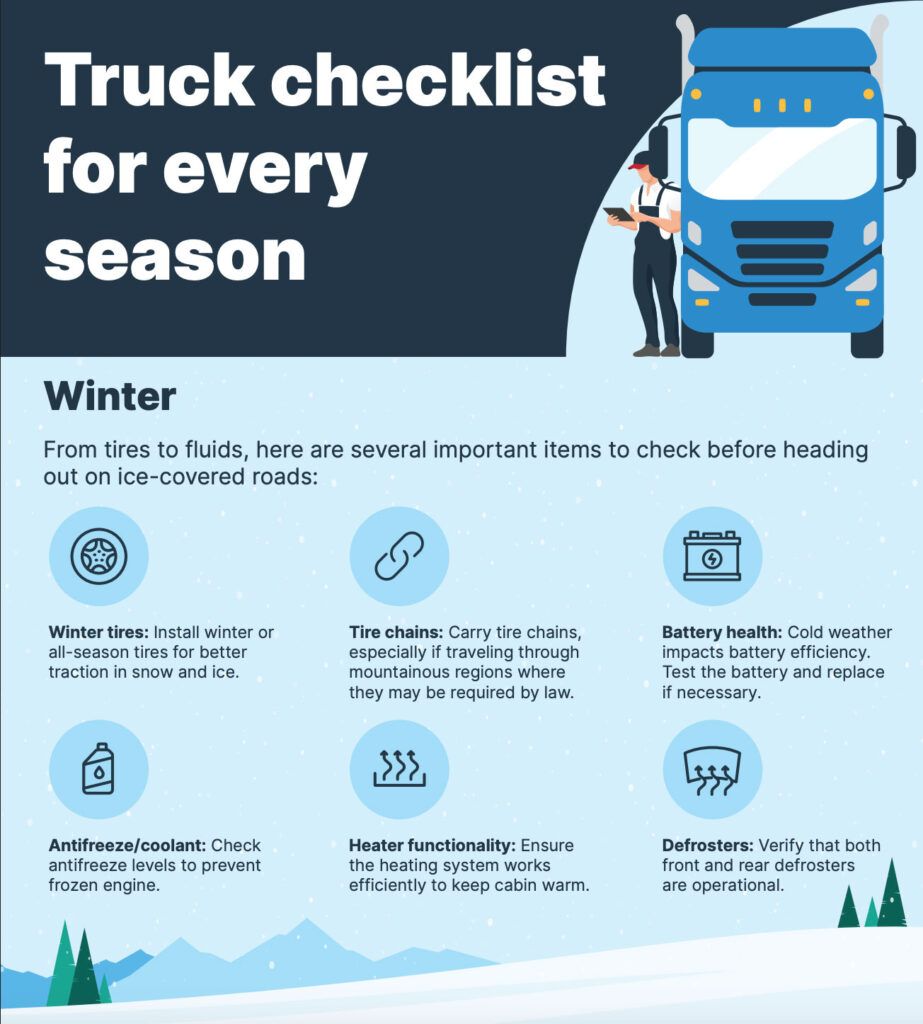Stay connected
Subscribe to our Inside WEX blog and follow us on social media for the insider view on everything WEX, from payments innovation to what it means to be a WEXer.

For those interested in a life on the road, OTR trucking is a career that can be rewarding. In fact, many would say that being a truck driver is more of a lifestyle choice than a career decision.
Every job has its difficulties, and being a long-haul trucker is no exception. In this article, we’ll discuss how the freedom and flexibility of trucking can also include challenges for career drivers but by following best-practices, truckers, fleet managers, and owners of trucking companies can work together to create healthy lives for truck drivers both on and off the road.

Your truck drivers will be well-prepared with this infographic sharing checklists for navigating every season on the road
Most careers come with challenges and hardships. For a trucking company, it’s up to each individual employer and driver to collaborate and navigate the inherent difficulties that being a road warrior brings. Together, you can ensure optimal health and well-being and even enhance job satisfaction.
Long-haul trucking, while regulated, involves working long hours—hours are capped at 60 hours every seven days or 70 hours every eight days. There are lots of great ways employers and professional truck drivers can mitigate the effects of long days and/or nights behind the wheel including:
Driving for a living has you sitting for periods of time, and sitting for too long can have negative health implications, and it can be difficult sometimes to find healthy food options while on the road. You’ll want to focus on finding healthy meals on the road and maintaining good stretching habits as you make your way between jobs as this will lead to both cardiovascular and musculoskeletal health.
Finding places to exercise, access healthcare, or even get a good meal are important goals while on the road. With this in mind, here are a few tips to help drivers:
Truck driving can offer a unique level of zen that other professions simply cannot match. While long hours spent alone sound ideal for many, so much time away from family and friends might sometimes contribute to feelings of isolation.
While tricky, here are a few ideas for employers to use to help their drivers navigate this unique element of their jobs:
There are numerous other ways truck drivers and their employers can support good work-life balance and good health on the road and off.
Allowing drivers to choose routes and schedules that align with their personal needs and preferences is a great way to facilitate their well-being. While the nature of the trucking industry sometimes leans on seniority for preferred routes, understanding why drivers prefer certain routes can help employers make choices rooted in practicality instead of tenure.
When drivers have a reliable sense of when they’ll have time off, they can better plan their personal lives. Whether to attend important events and occasions or simply spend time with their families, knowing when they’ll have downtime at home is integral to a healthy work-life balance.
While the level of control that companies have here may be minimal, there are a multitude of quality-of-life cab features and regular (but simple) maintenance checks that can help ensure a driver’s comfort, such as good ergonomic seating, safe and well-suited sleeping accommodations, and climate control.
Mechanical issues happen. When they do, that can cause stress for drivers who are already running on tight schedules. When things go wrong on the road, emergency roadside support can be a lifesaver – especially when employers offer a program that keeps their truckers from having to personally cover out-of-pocket costs to get their trucks back up and running.
Training goes a long way in the trucking industry and it applies to all job areas. For example, ensuring that drivers are clear on necessary safety protocols – and that those protocols are regularly reinforced – can help keep drivers safe including reducing accidents and avoiding other safety issues. Also, training on aspects like stress management, mindfulness, and other mental health strategies can help drivers gain control over their day and their health, and feel better prepared to take on a day on the road.
Tech tools can be a big help in trucking and can simplify both drivers’ and employers’ lives. For instance, the right fleet fuel card can help drivers fill up when and where they need to with extra protection from fraud, make it easy to purchase fleet- and business-related products and services, and bypass needing to collect and submit receipts.
For fleet managers, GPS and telematics tools can help give clear insight into their fleet vehicles and employees’ driving habits, improve routing, and plan preventive maintenance to keep trucks in good working order (keeping their drivers safe and reducing unnecessary downtime that can be highly disruptive to delivery schedules).
WEX over-the-road (OTR) solutions – including fleet fuel cards and telematics programs – are designed for truckers and fleet managers alike. With WEX, it’s simple to get equipped with the tools, tech, and data required to optimize fleet operations in ways that help drivers effectively manage their lives on the road and focus on delivering an excellent customer experience.
Truck driving as a career choice can lead to a life of freedom and flexibility, and while there isn’t a job that doesn’t have its challenges, there are some easy things you can do to help ease trucking challenges for yourself and your drivers. Start today creating a healthier experience for your truckers both on and off the road by following the tips above.
Curious about WEX OTR solutions? Browse WEX fuel cards, and OTR products and services and apply for a fleet card today!
All fleet cards are not the same, and different types of fuel cards suit the needs of different kinds and sizes of businesses. View WEX’s OTR fleet card comparison chart to see which fleet fuel card is right for you.
Learn more on how to better manage your over-the-road fleet:
Resources:
Men’s Journal
U.S. Bureau of Labor Statistics
National Highway Traffic Safety Administration
Mayo Clinic
Men’s Journal
Editorial note: This article was originally published on September 10, 2024, and has been updated for this publication.
Subscribe to our Inside WEX blog and follow us on social media for the insider view on everything WEX, from payments innovation to what it means to be a WEXer.